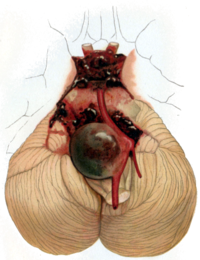
Photo from wikipedia
Purpose Intracranial atherosclerotic disease is a common etiology of ischemic strokes and stroke recurrence. Recent literature suggests treatment should be tailored according to plaque instability versus perfusion failure mechanisms, rather… Click to show full abstract
Purpose Intracranial atherosclerotic disease is a common etiology of ischemic strokes and stroke recurrence. Recent literature suggests treatment should be tailored according to plaque instability versus perfusion failure mechanisms, rather than the degree of stenosis. We aimed to study the difference in infarction patterns between anterior and posterior circulation intracranial atherosclerotic disease (ICAD), and their relationship to vascular risk factors and perfusion parameters. Methods A retrospective review of our institution’s prospective stroke database from Jan 2012 to May 2018 was performed. We identified patients with acute ischemic stroke (AIS) secondary to ICAD, restricted diffusion weighted imaging (DWI) findings attributed to a > 50% intracranial stenosis with or without perfusion abnormality, mean transit time (MTT) elevation, on MRI/MRA/MRP performed within one week of presentation. Infarction patterns were qualitatively graded as thromboembolic (TE), perforator (P), or watershed (W) in the vascular distributions of interest with agreement between two interventional neuroradiologists. Baseline demographics, vascular risk factors and correlation of DWI infarction patterns and perfusion MTT patterns were studied with respect to the anterior versus posterior intracranial circulation. Results We identified 55 patients with anterior circulation and 18 patients with posterior circulation infarcts secondary to ICAD. There was no difference in baseline demographics between both groups. Watershed infarctions were seen in 30% of symptomatic patients with anterior circulation ICAD. There were no significant differences observed in the non-watershed infarction patterns between anterior and posterior circulation disease (TE: 41% vs 44%, P: 38% vs 39% and mixed: 21% vs. 17%, p=0.908), respectively. mean transit time was equally elevated in both watershed (90%) vs. non-watershed (86%) anterior circulation ICAD, p=0.99. ICAD patients with posterior circulation infarcts were more likely to have suffered prior strokes/TIAs (73% vs 35%, p=0.016) with higher trends in diabetics (73% vs. 43%, p=0.068). Conclusion Hemodynamically significant stenosis is observed in the majority of symptomatic anterior circulation ICAD but is not necessarily associated with watershed DWI infarction patterns. Posterior circulation ICAD exhibits higher likelihood for stroke recurrence with a perforator or thromboembolic pattern of infarction. Combining MR vessel wall imaging techniques with DWI patterns of infarction and 4D flow MRA imaging to assess flow compromise in the posterior circulation may be beneficial in further discerning the mechanisms of ICAD related stroke, risks of stroke recurrence, and guide medical versus interventional therapies. Disclosures R. Abdalla: None. O. Ansari: None. M. Pan: None. D. Cantrell: None. A. Shaibani: None. M. Potts: None. M. Hurley: None. B. Jahromi: None. S. Ansari: None.
Journal Title: Journal of NeuroInterventional Surgery
Year Published: 2019
Link to full text (if available)
Share on Social Media: Sign Up to like & get
recommendations!